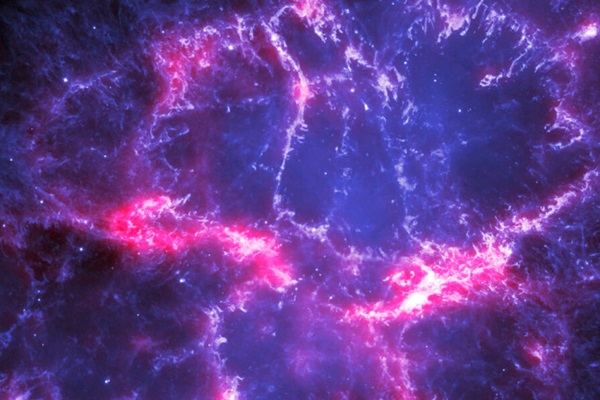What the interstellar medium tells us about the early universe – Astronomy Magazine
In the gases of the Crab Nebula, astronomers discovered argonium in what was the first detection of a naturally occurring, noble gas molecule. Located in the constellation Taurus, the Crab Nebula (shown in a composite image from two telescopes) is the debris left over from a massive star explosion that lit the skies above Earth in 1054.
ESA/Herschel/PACS/Mess Key Programme Supernova Remnant Team; NASA, ESA and Allison Loll/Jeff Hester/Arizona State University
Then, in 2019, observers reported finding a second kind of noble gas molecule, one they had sought for more than three decades and of a type that was the very first to form after the universe’s birth in the big bang. This newly found molecule lends insight into the chemistry of the early universe, before any stars began to shine or any galaxies had formed. The discovery may even help astronomers understand how the first stars arose.
Most chemical elements readily share electrons with other elements to make molecules, but noble gases normally don’t. “Noble gases are in some sense happy as they are,” says Peter Schilke, an astrophysicist at the University of Cologne in Germany. That’s because the outer shell of a noble gas atom already has its fill of electrons, so it won’t ordinarily exchange electrons to bond with other atoms and form molecules — at least, not here on Earth.
In retrospect, space seems the perfect place to seek noble gas molecules, because these gases abound in the cosmos. Helium is the second most common element in the universe, after hydrogen, and neon ranks fifth or sixth. And in interstellar space, where extreme temperatures and densities are the rule, noble gases do things they would never do on Earth. That includes forming molecules.
In addition to providing insight into the universe’s infancy, these exotic molecules tell scientists about the current conditions in the space between the stars — the gases that make up the interstellar medium — which is of intense interest to astronomers. “The interstellar medium is the place where stars and planetary systems are born,” says Maryvonne Gerin, an astrophysicist at the Observatory of Paris and coauthor of a 2016 Annual Review of Astronomy and Astrophysics article on interstellar molecules.
Here on Earth, scientists have been concocting noble gas molecules for nearly a century. In 1925, laboratory scientists were able to force the noble gas helium into a bond with hydrogen to form helium hydride, or HeH+ — termed a molecule by astronomers but, because it’s electrically charged, a molecular ion by chemists.
In 1962 chemist Neil Bartlett coaxed xenon to mate with fluorine and platinum, yielding a mustard-colored compound that was a first: a substance consisting of electrically neutral molecules which both astronomers and chemists are happy to say is full of noble gas molecules. Still, no one has ever seen any naturally occurring noble gas molecules on Earth.
So it seemed this combo would be the most likely quarry for astronomers as well. Instead, they were caught off guard by an even stranger molecule.
An Interstellar Embarrassment
Argon is more than 20 times as common in Earth’s atmosphere as carbon dioxide but gets far less press. In fact, it is the third most abundant gas in the air you breathe. Nitrogen and oxygen make up 78 percent and 21 percent of Earth’s atmosphere, respectively, while argon accounts for most of the remaining 1 percent.
But nobody was looking for an interstellar molecule containing argon. “It was basically a serendipitous discovery,” says University College London astrophysicist Mike Barlow, who led the team that accidentally found ArH+: argonium, which consists of argon and hydrogen.







